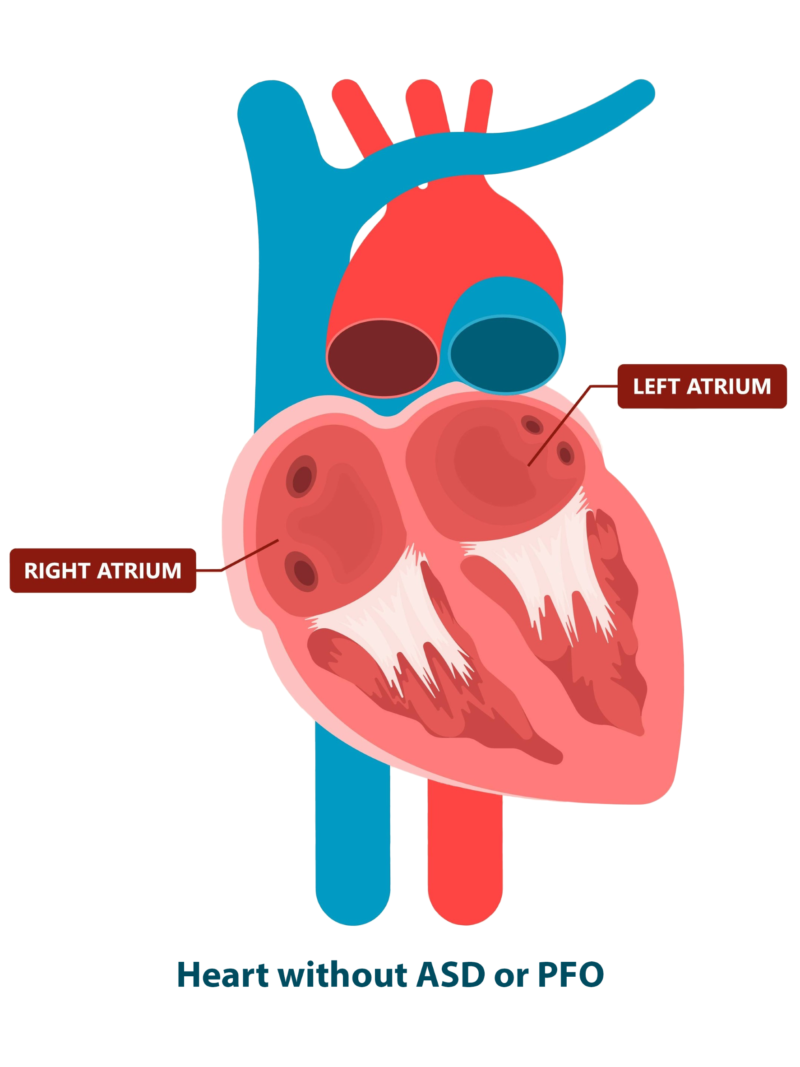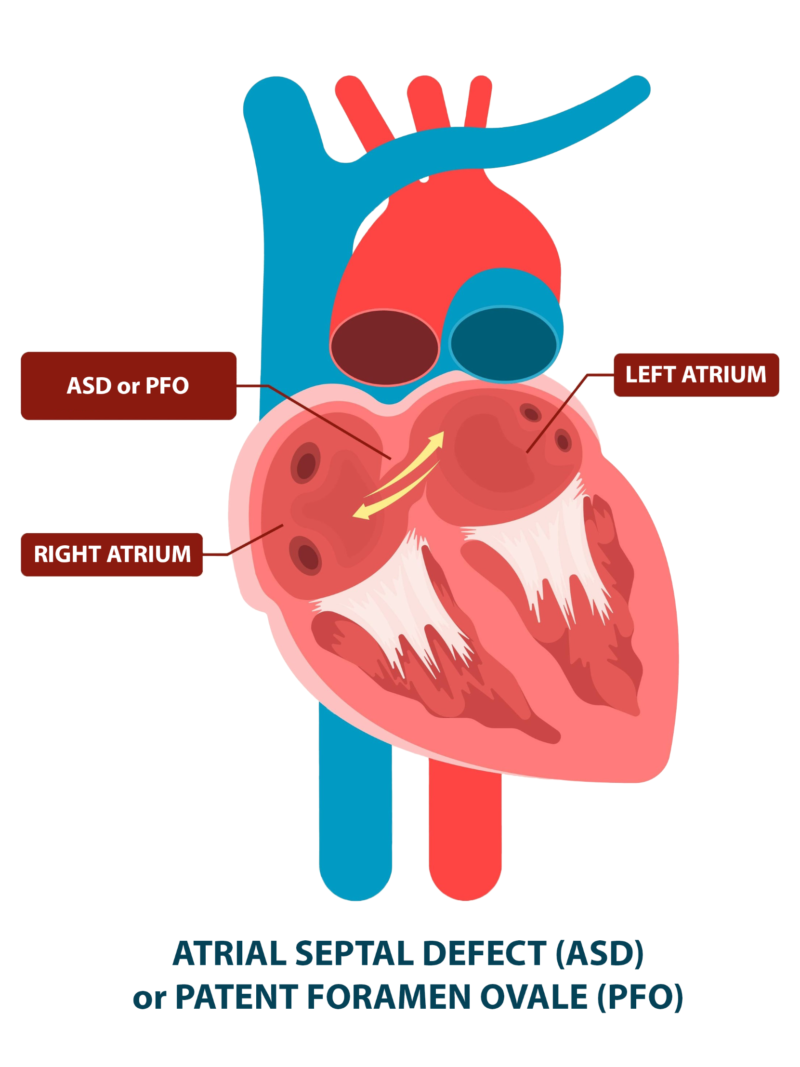ASD & PFO Closures
What is ASD and PFO?
ASD (atrial septal defect) and PFO (patent foramen ovale) are very similar in that they are both a type of hole between the left and right atriums (upper chambers of the heart). Generally, neither an ASD or PFO will cause complications, but in rare cases, in patients with certain conditions, an ASD or PFO can be related to unexplained strokes and migraines. In certain clinical situations patients qualify to have this defect closed. This is done by inserting a catheter (a long thin tube) through a vein in the groin and advancing it up into the heart. The closure device is then passed through the catheter, and once in the heart, it opens to securely cover the ASD or PFO.


MitraClip™ (Transcatheter Mitral Valve Repair)
What is Mitral Insufficiency or Regurgitation?
Oxygenated blood from the lungs enters the upper left heart chamber (left atrium) and passes through the mitral valve down into the bottom left heart chamber (left ventricle). The mitral valve has 2 flaps called leaflets that open to let the blood flow forward into the left ventricle, and close to keep blood from flowing backwards into the left atrium. If the mitral valve doesn’t close properly, this will result in a leak, allowing the blood to travel backwards into the left atrium. This leak is called mitral insufficiency or regurgitation (MR). Causes of MR can include a previous heart attack, mitral valve prolapse (when the leaflets bulge into the left atrium), damaged heart tissue cords that attach the leaflets to the heart wall, calcium accumulation, high blood pressure, or congenital heart defects. MR results in blood backflow to the lungs and decreased forward blood flow to vital organs of the body. Ultimately, it leads to worsening shortness of breath, fatigue and need for repeated hospitalizations. The traditional treatment of MR is mitral valve repair and replacement surgery.
What is Mitra Clip?
MitraClip™ (Transcatheter Mitral Valve Repair) is an alternative minimally invasive treatment option for patients with mitral insufficiency or regurgitation (MR) that are not candidates for mitral valve repair and replacement surgery. During the procedure, the doctor makes a small incision in the groin (femoral vein) and advances a long thin tube, called a catheter, through the vein leading up into the heart. A metallic clip is advanced through the catheter to the leaking valve. This MitraClip™ clips the leaking leaflets closer together, resulting in a reduced backflow of blood. Once the MitraClip™ is secure and functioning correctly, the doctor removes the catheter.
MitraClip™ is less invasive than conventional surgery. It improves survival, symptoms and quality of life.
TAVR (Transcatheter Aortic Valve Replacement)
What is Aortic Stenosis?
The aortic valve allows blood to pass from the lower left heart chamber (left ventricle) into the aorta, the body’s main artery responsible for distributing oxygenated blood from the heart to all other organs. Aortic stenosis is the narrowing of the valve due to calcium accumulation with age. It results in reduced blood flow to the body and increased strain on the left ventricle. Ultimately, this leads to symptoms including shortness of breath, chest pain and passing-out. If untreated, severe aortic stenosis can lead to death in up to 50 percent of patients. The traditional treatment of aortic stenosis is open-heart surgery with surgical aortic valve replacement.
What is TAVR?
TAVR (Transcatheter Aortic Valve Replacement) is a minimally invasive alternative to conventional surgery, that treats aortic stenosis. This procedure involves a special catheter (long thin tube) with a closed balloon at the tip. The replacement stent-based valve is mounted over the closed balloon. This catheter is inserted via a small groin incision, advanced up the femoral artery and through the aorta, stopping at the aortic valve. The balloon on the catheter is inflated, expanding the new valve into place, and pushing aside the old valve. The procedure is performed in the presence of an interventional cardiologist, a cardiac surgeon and a specialized anesthesiologist. TAVR improves survival, symptoms and quality of life.
WATCHMAN
Atrial Fibrillation and the Left Atrial Appendage (LAA)
Atrial fibrillation (Afib) is a type of rapid irregular heartbeat. It can cause blood to pool in an area of the heart called the left atrial appendage (LAA) The LAA is a pouch located off your upper left heart chamber (left atrium). When the blood pools, it can cause clots to form. If the clot escapes from the LAA, it can cut off the blood supply to the brain, resulting in a stroke. Up to 90% of stroke causing blood clots originate from the LAA. Closing off the LAA prevents the clot from escaping, therefore reducing the risk of stroke in patients with Afib not caused by a heart valve problem.
What is a WATCHMAN Device?
WATCHMAN is a permanent implant that reduces the risk of stroke for people with atrial fibrillation not caused by a heart valve problem. The WATCHMAN device is the size of a quarter and fits right into the left atrial appendage. It permanently closes off the LAA so no clots will escape.
During this minimally invasive procedure, the doctor makes a small incision in the groin (femoral vein) and advances a long thin tube, called a catheter, up into the heart. The doctor guides the WATCHMAN through the catheter to the LAA. The WATCHMAN is then deployed into the LAA and expands. Once the WATCHMAN is securely in place, the catheter is removed. Over time, a thin wall of tissue grows over the WATCHMAN device to permanently seal off the LAA. Most people are able to stop taking warfarin/blood thinners after 45 days after the implantation. This procedure is done in one of our hospitals by our structural cardiologist.
This procedure offers an alternative to the lifelong use of warfarin without the risk of bleeding that all oral anticoagulants have. WATCHMAN eliminates the need for regular blood tests and food and drink restrictions that come with warfarin/Coumadin.


